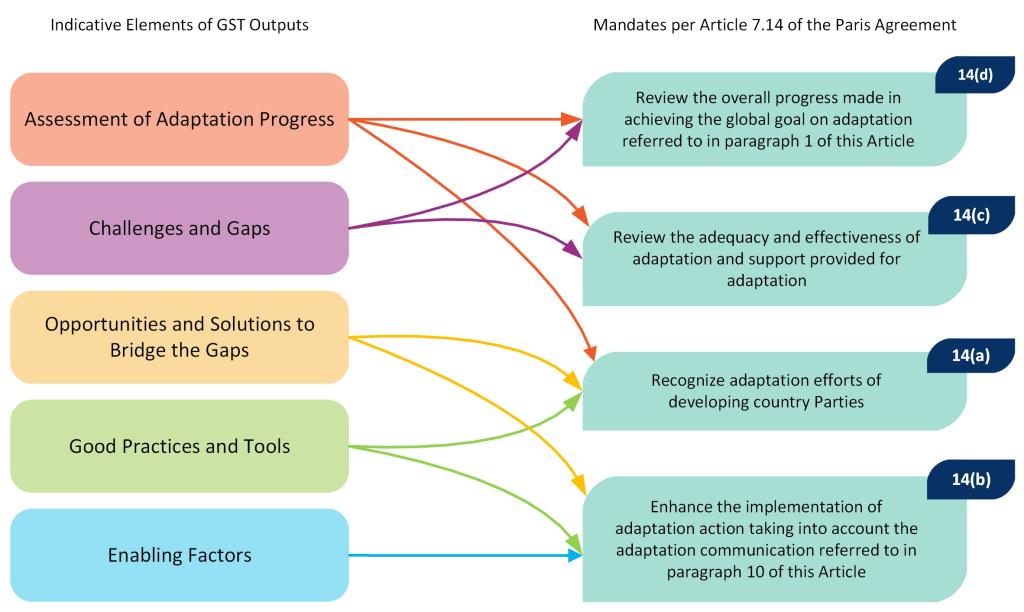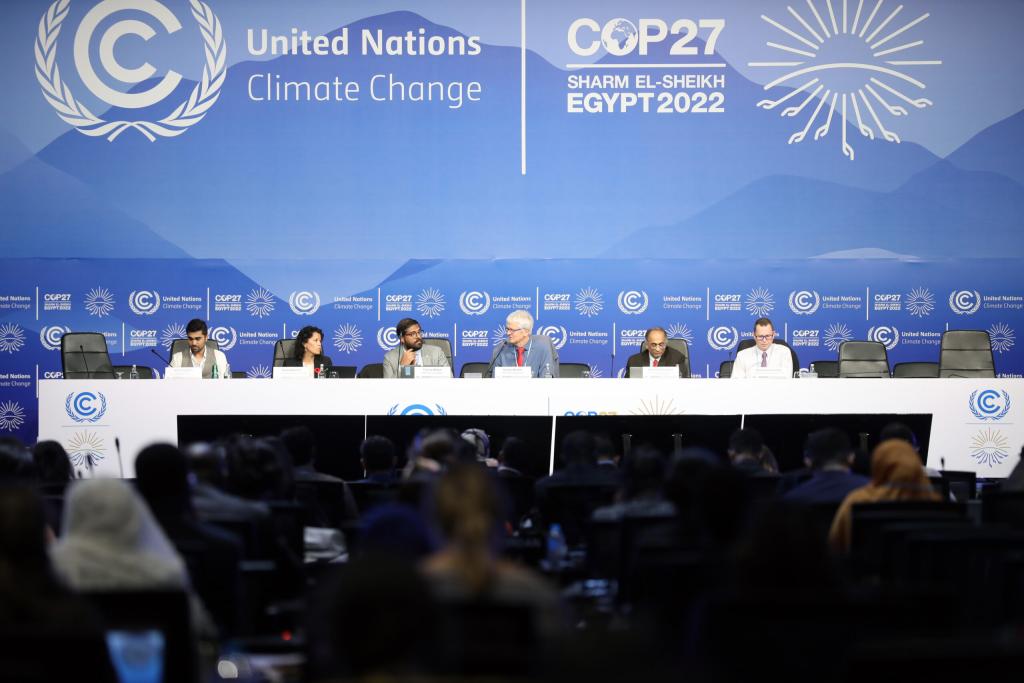Last Call for the Global Stocktake
What you need to know on adaptation before the technical dialogue process ends at SB58 in Bonn
This article was originally published via the National Adaptation Plan (NAP) Global Network and is reprinted in its entirety below.
A year ago at the 2022 Bonn Climate Change Conference (SB56), countries kickstarted the technical dialogue (TD) process, a critical part of the global stocktake (GST) under the Paris Agreement. During the GST process, country representatives and non-party stakeholders, including scientific experts, practitioners, and observers, have been sharing their insights, experiences, and expertise on mitigation, adaptation, and loss and damage, and means of implementation, as well as their assessments on whether we are on track to meet the long-term goals of the Paris Agreement.
Building on the first TD (TD1.1) held at SB56 and the second TD (TD1.2) held at COP 27, the upcoming 2023 Bonn Climate Change Conference (SB58) will see the third and last installment of the Technical Dialogue (TD1.3) take place before the political consideration of outputs phase commences. This phase will start at the United Nations Framework Convention on Climate Change (UNFCCC) Twenty-Eighth Conference of the Parties (COP 28) in Dubai, United Arab Emirates. (SBs, in climate parlance, refer to the meetings of the UNFCCC’s subsidiary bodies.)
In this article, we revisit the first two Technical Dialogues to take stock of what key messages on climate change adaptation have been captured thus far, what TD1.3 participants could emphasize on adaptation, and the next steps for the GST process.
Climate Change Adaptation and the GST
Taking place every five years, the GST acts as an assessment and learning mechanism for the Paris Agreement, serving as a main part of the Agreement’s ratcheting mechanism to increase ambition for climate action. Article 7 of the Paris Agreement specifically tasked the GST with recognizing developing countries’ adaptation efforts and reviewing the overall progress made in adaptation and resilience-building actions (see the right-hand side of the below figure for the mandates from the Paris Agreement on adaptation for the GST).
To this end, the GST seeks to collect information and reflections on the following elements, in line with the Paris Agreement’s mandates (see the left-hand side of the below figure):
- The state of global adaptation progress.
- Challenges and gaps identified by countries and relevant stakeholders.
- Opportunities and solutions to bridge gaps and address challenges.
- Good practices and tools to enhance global adaptation actions.
- Enabling factors supporting effective and transformative adaptation.

TD Key Messages: Increasing adaptation ambition, but with uneven progress
The TD on adaptation provides a forum for exchange and discussion on adaptation planning and implementation. This information will then be captured as part of the GST’s outputs. Based on the TD co-facilitators’ summary reports from the past year, we highlight three key messages shared to date.
1) While adaptation progress has been significant, it is still inadequate, and many challenges and gaps exist.
From the latest Intergovernmental Panel on Climate Change (IPCC) reports and reflections shared by participants, it is clear that the impacts of climate change can be felt across the globe. Countries are stepping up their adaptation ambition, amongst others, through the formulation and implementation of their National Adaptation Plans (NAPs) and related strategies. At the time of the second TD, 139 of the 154 developing countries had NAP processes underway, while 45 countries had already developed and communicated their NAP documents to the UNFCCC. In addition, 57 countries have submitted adaptation communications (AdComs) that outline their experiences and efforts to build resilience. However, despite significant collective progress on adaptation, the transition from planning to implementation remains slow, uneven, and incremental.
"Collectively, there is increasing ambition in plans and commitments for adaptation, but there also remains an implementation gap, in that plans are implemented inadequately, unevenly, and incrementally."
Country representatives highlighted key challenges they face, such as a lack of capacity to analyze and use climate information, trouble accessing downscaled data, and insufficient support for establishing functioning and sustainable monitoring, evaluation, and learning (MEL) systems for adaptation.
Experts and country representatives agreed that the provision of support and adaptation finance flows are not aligned with the level of climate impacts experienced by the most vulnerable countries.
At the upcoming TD1.3, participants should continue to highlight the essential role of the NAP process and the importance of continued support toward helping countries formulate and implement their adaptation actions. Emphasizing these points is invaluable for these critical reflections are captured in the final output.
2) More information on opportunities, solutions, good practices, and tools are needed to help countries enhance adaptation actions.
Participants agreed that adaptation planning and implementation is a continuous and iterative process building on previous actions and drawing from a robust MEL system. Adaptation should be driven by local priorities and circumstances, while ensuring financial flows are realigned so these do not contribute to maladaptation, but instead go toward robust, inclusive, equitable, and participatory adaptation.
Vertical integration, ecosystem-based adaptation, inclusive and gender-responsive adaptation planning processes, effective private sector engagement, and the application of the rights and knowledge of local communities and Indigenous peoples have also been identified as essential practices for fair and effective adaptation.
At TD1.3, participants should focus on compiling actionable solutions. This forward-looking perspective can most usefully highlight next steps to bridge the gaps identified in the previous TDs and facilitate the transition from planning to implementation. It will be equally important for the participants to stress the crucial role a functioning MEL system for adaptation plays in countries’ adaptation policy cycles, as well as connecting the GST process to the ongoing discussions under the Glasgow-Sharm el-Sheikh (GlaSS) work programme on the Global Goal on Adaptation (GGA).

3) Countries are using a set of enabling factors to coordinate adaptation across sectors and scales of governance and to enable iterative planning and implementation, continuous learning, and transformational adaptation.
Participants have identified the following key enabling factors that underpin countries’ national adaptation planning processes:
- High-level political buy-in and support towards adaptation: Only when high-level political buy-in is available can adaptation be mainstreamed and prioritized.
- Adequate financing and capacity: Sustainable adaptation financing, as well as investments in capacity-building, enable effective adaptation planning and implementation.
- Synergistic institutional arrangements for mainstreaming and policy coherence: Overcoming the often fragmented, segmented, and siloed approaches to adaptation is key to mainstreaming adaptation and building resilience across sectors.
- Multilevel governance: Vertical integration and alignment between national, subnational, and local adaptation planning and implementation is essential for addressing the differential impacts of climate change and the various contexts and factors contributing to vulnerabilities.
- Participatory approaches and inclusion: A strong focus on cross-cutting and intersectional issues like gender, social inclusion, Indigenous peoples’ rights, and the integration of local and traditional knowledge and knowledge systems enables the co-creation of adaptation actions. The role of non-state actors in national adaptation planning and implementation also cannot be overlooked.
At TD1.3, participants will have the opportunity to formally organize these enabling factors and share tools and best practices associated with each.
The Road to COP 28
TD1.3 at the upcoming SB58 will be the last opportunity for countries and other stakeholders to provide technical inputs before the political part of the GST starts. To ensure their messages are included in the Consideration of Outputs (CO) phase at COP 28, participants need to first make sure their inputs are captured in the Factual Synthesis Report (SYR), which is the compilation of all emerging messages and discussion outcomes across the three TDs.

At SB58, country negotiators will start discussing how the CO phase will be carried out and how the GST process will communicate its outputs. The COP 28 presidency, along with the Chairs of the UNFCCC Subsidiary Bodies, will host a high-level event in Dubai to send a political signal that acknowledges the outputs of the GST and commits to increasing climate ambition. A decision or a declaration under the Conference of the Parties serving as the meeting of the Parties to the Paris Agreement (CMA) at COP 28 will also be negotiated by countries to highlight key messages and assessment results from the TDs and provide follow-up instructions as appropriate.
However, much of the CO phase is still up in the air and pending countries’ negotiation. TD1.3 and SB58 will be the last window for countries and relevant stakeholders to highlight what they feel is the most important evidence to help shape the next generation of policies on adaptation and ensure the Paris Agreement’s first GST delivers on its mandate.
You might also be interested in
Shifting the narrative on adaptation at COP27
At the "Adaptation COP" in Sharm el-Sheikh, Egypt, the Adaptation Without Borders partnership led by SEI, ODI and IDDRI advanced the narrative that climate risk is a shared reality and adaptation must become a collective responsibility.
Learning From Gender-Responsive National Adaptation Plan Processes: Insights from countries to inform the review of the UNFCCC Gender Action Plan
Based on the priority actions of 10 African and Caribbean countries for integrating gender equality in their National Adaptation Plan (NAP) processes, we identified recommendations for effectively advancing the Gender Action Plan (GAP) under the United Nations Framework Convention on Climate Change (UNFCCC).
What Does an Inclusive Global Stocktake Look Like for Civil Society?
The inaugural Global Stocktake will conclude at COP 28 in 2023. With the process well underway, the current and upcoming phases of the Global Stocktake must be open and inclusive in order to succeed.
Putting Equity at the Heart of the Global Stocktake
Capturing the world's collective progress towards achieving the Paris Agreement goals requires a look at who is being left behind and what we must do to create an equitable, climate-resilient future for all.
